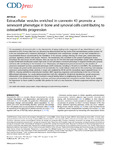Mostrar o rexistro simple do ítem
Extracellular Vesicles Enriched in Connexin 43 Promote a Senescent Phenotype in Bone and Synovial Cells Contributing to Osteoarthritis Progression
| dc.contributor.author | Varela-Eirín, Marta | |
| dc.contributor.author | Carpintero-Fernández, Paula | |
| dc.contributor.author | Guitián-Caamaño, Amanda | |
| dc.contributor.author | Varela Vázquez, Adrián | |
| dc.contributor.author | García-Yuste, Alejandro | |
| dc.contributor.author | Sánchez Temprano, Agustín | |
| dc.contributor.author | Bravo López, Susana Belén | |
| dc.contributor.author | Yáñez-Cabanas, José | |
| dc.contributor.author | Fonseca, Eduardo | |
| dc.contributor.author | Largo, R. | |
| dc.contributor.author | Mobasheri, Ali | |
| dc.contributor.author | Caeiro, José Ramón | |
| dc.contributor.author | Mayán, María D. | |
| dc.date.accessioned | 2022-10-14T18:50:17Z | |
| dc.date.available | 2022-10-14T18:50:17Z | |
| dc.date.issued | 2022 | |
| dc.identifier.citation | Varela-Eirín, M., Carpintero-Fernández, P., Guitián-Caamaño, A. et al. Extracellular vesicles enriched in connexin 43 promote a senescent phenotype in bone and synovial cells contributing to osteoarthritis progression. Cell Death Dis 13, 681 (2022). https://doi.org/10.1038/s41419-022-05089-w | es_ES |
| dc.identifier.issn | 2041-4889 | |
| dc.identifier.uri | http://hdl.handle.net/2183/31819 | |
| dc.description.abstract | [Abstract] The accumulation of senescent cells is a key characteristic of aging, leading to the progression of age-related diseases such as osteoarthritis (OA). Previous data from our laboratory has demonstrated that high levels of the transmembrane protein connexin 43 (Cx43) are associated with a senescent phenotype in chondrocytes from osteoarthritic cartilage. OA has been reclassified as a musculoskeletal disease characterized by the breakdown of the articular cartilage affecting the whole joint, subchondral bone, synovium, ligaments, tendons and muscles. However, the mechanisms that contribute to the spread of pathogenic factors throughout the joint tissues are still unknown. Here, we show for the first time that small extracellular vesicles (sEVs) released by human OA-derived chondrocytes contain high levels of Cx43 and induce a senescent phenotype in targeted chondrocytes, synovial and bone cells contributing to the formation of an inflammatory and degenerative joint environment by the secretion of senescence-associated secretory associated phenotype (SASP) molecules, including IL-1ß and IL-6 and MMPs. The enrichment of Cx43 changes the protein profile and activity of the secreted sEVs. Our results indicate a dual role for sEVs containing Cx43 inducing senescence and activating cellular plasticity in target cells mediated by NF-kß and the extracellular signal-regulated kinase 1/2 (ERK1/2), inducing epithelial-to-mesenchymal transition (EMT) signalling programme and contributing to the loss of the fully differentiated phenotype. Our results demonstrated that Cx43-sEVs released by OA-derived chondrocytes spread senescence, inflammation and reprogramming factors involved in wound healing failure to neighbouring tissues, contributing to the progression of the disease among cartilage, synovium, and bone and probably from one joint to another. These results highlight the importance for future studies to consider sEVs positive for Cx43 as a new biomarker of disease progression and new target to treat OA. | es_ES |
| dc.description.sponsorship | This work was supported in part through funding from Health Institute ‘Carlos III’ (ISCIII, Spain), the European Regional Development Fund, ‘A way of making Europe’ from the European Union (to MDM): grant PI19/00145; a grant from the Joint Transnational Call for Proposals for “European Innovative Research & Technological Development Projects in Nanomedicine” EURONANOMED III (AC21_2/00026) (to MDM); a grant from Xunta de Galicia (IN607B2020/12) (to MDM) and from H2020, Future and Emerging Technologies (grant 858014 “PANACHE”) to MDM. MV-E was funded with a predoctoral (ED481A-2015/188) and post-doctoral fellowship (IN606B-2019/004) from Xunta de Galicia. AG-C was funded with a predoctoral fellowship (FIS20/00310) from ISCIII. PC-F was funded with a post-doctoral fellowship and a grant from Xunta de Galicia (INB606B 2017/014 and IN606C 2021/006). We thank members of the CellCOM group for helpful technical suggestion, María Dolores Álvarez Alvariño (CHUS) for generously collecting tissue samples in the operating room after surgery and Arantxa Tabernero (INCYL, University of Salamanca) for kindly providing the human Cx43 plasmid used in this study | es_ES |
| dc.description.sponsorship | Xunta de Galicia; IN607B2020/12 | es_ES |
| dc.description.sponsorship | Xunta de Galicia; ED481A-2015/188 | es_ES |
| dc.description.sponsorship | Xunta de Galicia; IN606B-2019/004 | es_ES |
| dc.description.sponsorship | Xunta de Galicia; INB606B 2017/014 | es_ES |
| dc.description.sponsorship | Xunta de Galicia; IN606C 2021/006 | es_ES |
| dc.language.iso | eng | es_ES |
| dc.publisher | Springer Nature | es_ES |
| dc.relation | info:eu-repo/grantAgreement/EC/H2020/723770 | |
| dc.relation | info:eu-repo/grantAgreement/EC/H2020/858014 | |
| dc.relation | info:eu-repo/grantAgreement/ISCIII/Plan Estatal de Investigación Científica y Técnica y de Innovación 2017-2020/PI19%2F00145/ES/FARMACOS DE NUEVA GENERACION BASADOS EN COMPUESTOS PEPTIDOMIMETICOS MODULADORES DE LAS CONEXINAS COMO AGENTES TERAPEUTICOS PARA RESTAURAR LA REGENERACION TISULAR EN PIEL Y CARTILAGO ARTICULAR/ | |
| dc.relation | info:eu-repo/grantAgreement/ISCIII/Plan Estatal de Investigación Científica y Técnica y de Innovación 2017-2020/FIS20%2F00310/ES/ | |
| dc.relation.uri | https://doi.org/10.1038/s41419-022-05089-w | es_ES |
| dc.rights | Atribución 4.0 Internacional (CC BY 4.0) | es_ES |
| dc.rights.uri | https://creativecommons.org/licenses/by/4.0/ | * |
| dc.subject | Osteoarthritis | es_ES |
| dc.subject | Predictive markers | es_ES |
| dc.title | Extracellular Vesicles Enriched in Connexin 43 Promote a Senescent Phenotype in Bone and Synovial Cells Contributing to Osteoarthritis Progression | es_ES |
| dc.type | info:eu-repo/semantics/article | es_ES |
| dc.rights.access | info:eu-repo/semantics/openAccess | es_ES |
| UDC.journalTitle | Cell Death & Disease | es_ES |
| UDC.volume | 13 | es_ES |
| UDC.startPage | 681 | es_ES |
| dc.identifier.doi | 10.1038/s41419-022-05089-w |
Ficheiros no ítem
Este ítem aparece na(s) seguinte(s) colección(s)
-
GI- Quimolmat - Artigos [89]
-
OpenAIRE [287]






